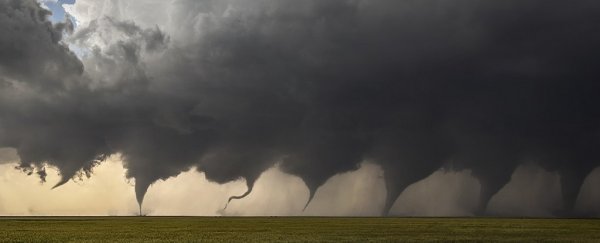Historically, tornadoes have been thought to originate in the clouds, reaching turbulent fingers down to Earth. But now a team of climatologists has demonstrated that this 'top-down' model of tornadogenesis might actually be wrong.
Yep. Tornadoes, their research has found, form from the ground up.
Tornadoes can form surprisingly quickly, in just a couple minutes. That's why capturing the birth of one isn't exactly easy, especially near the ground where trees and houses can get in the way. Still, meteorologist Jana Houser from Ohio University has been chasing them for years.
Using a rapid-scanning mobile Doppler radar, she was able to obtain comprehensive data on four tornadoes born of rare and magnificent (and dangerous) supercell storms.
These were two small ones in 2012, outside of Galatia and Russell in Kansas, registering 1 out of 5 on the Enhanced Fujita tornado intensity scale; one EF3 near El Reno, Oklahoma in 2011; and a particular monster that struck near El Reno in 2013, an EF5 which at 4.2 kilometres (2.6 miles) is the widest tornado ever measured.
And not a single one of them started in the sky, according to Houser and her team's data.
They started with the 2013 El Reno tornado. Because of the team's hilltop vantage point, they were able to obtain what they called an "unprecedented dataset" during tornadogenesis, as low as 10 metres (32 feet) above the ground.
In addition, storm chasers were in attendance in droves - which led to a wealth of photographic data as well. The team had access to hundreds of photographs of the event, which they compared with their radar measurements of wind speed.
And this is where it got curious: because the photographs showed a clear tornado funnel on the ground before the radar data showed any rotation at higher altitudes. So they went back to their radar data and reanalysed it, finding rotation on the ground before it materialised in the clouds.
Data sets from the three other tornadoes showed similar patterns, although the 2011 El Reno tornado showed rotation at a multiple different elevations simultaneously. That indicates that there may be different modes of tornadogenesis, but even so, it did not start in the sky and work its way down.
"It appears that in many cases," the team wrote in their abstract, "tornadic-strength rotation develops either at near-ground levels first, or contemporaneously throughout the depth of the tornado-bearing layer."
Of course, four is a pretty small sample size, considering that an average of more than 1,000 tornadoes is recorded in the US every year.
But, given that every year people are also injured or killed by these storms, knowing how they form could help protect people. Currently tornado detection is based on wind speed in the clouds. If their formation begins closer to the ground - and if it can be detected - that could add precious seconds to early tornado warnings.
More data and data analysis will probably be required. But Houser and her team have tornadoes by the tail. We can't wait to see what they haul in.
The team presented their research on December 14 at the 2018 meeting of the American Geophysical Union.
